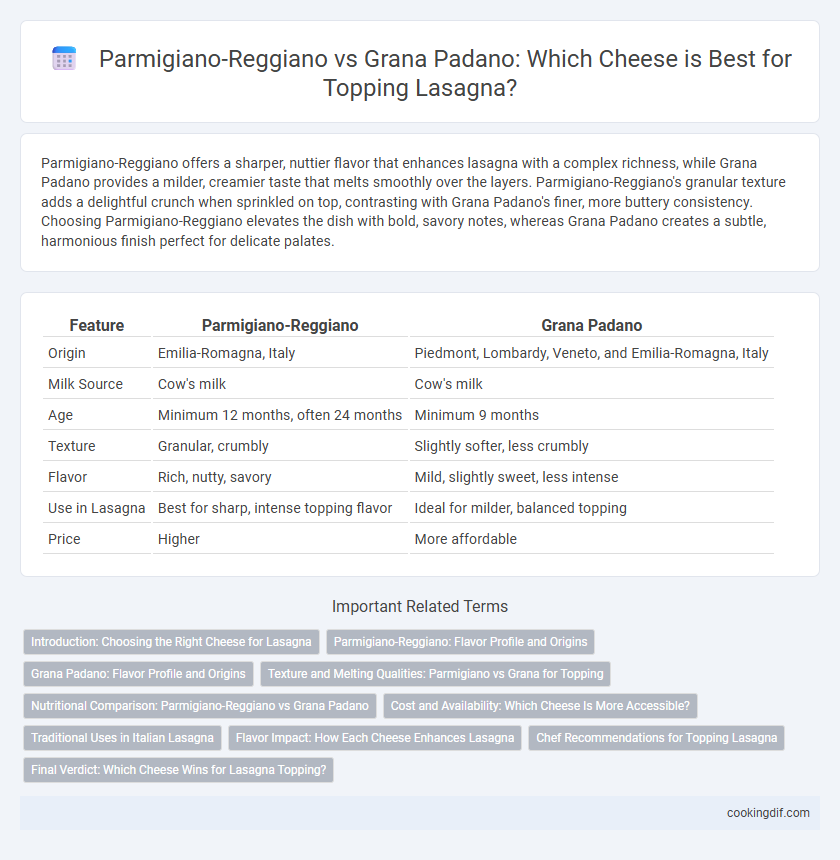Parmigiano-Reggiano offers a sharper, nuttier flavor that enhances lasagna with a complex richness, while Grana Padano provides a milder, creamier taste that melts smoothly over the layers. Parmigiano-Reggiano's granular texture adds a delightful crunch when sprinkled on top, contrasting with Grana Padano's finer, more buttery consistency. Choosing Parmigiano-Reggiano elevates the dish with bold, savory notes, whereas Grana Padano creates a subtle, harmonious finish perfect for delicate palates.
Table of Comparison
| Feature | Parmigiano-Reggiano | Grana Padano |
|---|---|---|
| Origin | Emilia-Romagna, Italy | Piedmont, Lombardy, Veneto, and Emilia-Romagna, Italy |
| Milk Source | Cow's milk | Cow's milk |
| Age | Minimum 12 months, often 24 months | Minimum 9 months |
| Texture | Granular, crumbly | Slightly softer, less crumbly |
| Flavor | Rich, nutty, savory | Mild, slightly sweet, less intense |
| Use in Lasagna | Best for sharp, intense topping flavor | Ideal for milder, balanced topping |
| Price | Higher | More affordable |
Introduction: Choosing the Right Cheese for Lasagna
Parmigiano-Reggiano and Grana Padano are both Italian hard cheeses ideal for lasagna toppings due to their rich umami flavors and excellent melting properties. Parmigiano-Reggiano boasts a more complex, nutty taste and granular texture from its longer aging process, enhancing the depth of lasagna layers. Grana Padano offers a milder, creamier profile with a slightly faster maturation, making it a versatile and cost-effective option without sacrificing authentic Italian taste.
Parmigiano-Reggiano: Flavor Profile and Origins
Parmigiano-Reggiano, often called the "King of Cheeses," boasts a complex flavor profile combining nutty, fruity, and savory notes with a granular texture that enhances lasagna toppings. Produced exclusively in designated provinces of Italy with strict aging requirements of at least 12 months, Parmigiano-Reggiano offers a depth of flavor unmatched by Grana Padano, which has a milder, less nuanced taste due to shorter aging and broader production regulations. This cheese's intense aroma and crystalline texture melt beautifully over layers of pasta, bechamel, and ragu, elevating the traditional lasagna experience.
Grana Padano: Flavor Profile and Origins
Grana Padano, originating from the fertile Po River Valley in Northern Italy, offers a delicate yet rich flavor profile with a slightly sweet and nutty taste that enhances the layers of lasagna. Its crumbly texture and aged complexity provide a balanced savory note without overpowering the tomato sauce or bechamel. Compared to Parmigiano-Reggiano, Grana Padano is milder, making it an ideal topping for those seeking a subtle cheese complement that melts beautifully over the baked pasta.
Texture and Melting Qualities: Parmigiano vs Grana for Topping
Parmigiano-Reggiano offers a granular, slightly crumbly texture that melts smoothly, creating a rich, savory topping with a nutty depth ideal for lasagna's layered structure. Grana Padano features a finer, less crumbly texture and melts more uniformly, producing a creamier, milder finish that complements without overpowering the tomato sauce and bechamel. Choosing Parmigiano-Reggiano enhances the lasagna's complexity with its robust melting qualities, while Grana Padano provides a subtle, consistent melt for a delicate balance.
Nutritional Comparison: Parmigiano-Reggiano vs Grana Padano
Parmigiano-Reggiano contains approximately 431 calories, 29 grams of protein, and 28 grams of fat per 100 grams, offering a rich source of calcium and phosphorus critical for bone health. Grana Padano has slightly fewer calories at about 392 per 100 grams, with 33 grams of protein and 28 grams of fat, also providing essential minerals like calcium and phosphorus. Both cheeses are low in carbohydrates and high in sodium, but Parmigiano-Reggiano typically has a higher concentration of beneficial vitamins such as vitamin A and B12, making it a nutrient-dense choice for lasagna toppings.
Cost and Availability: Which Cheese Is More Accessible?
Parmigiano-Reggiano commands a higher price due to its stringent production standards and aging process, making it less accessible for regular use compared to Grana Padano, which is more affordable and widely available. Grana Padano's production allows for a shorter aging period and broader distribution, increasing its availability in supermarkets and specialty stores. Consumers seeking cost-effective options for lasagna toppings often prefer Grana Padano without significantly compromising flavor quality.
Traditional Uses in Italian Lasagna
Parmigiano-Reggiano is traditionally preferred for topping Italian lasagna due to its rich umami flavor and granular texture that melts beautifully, enhancing the dish's authentic taste. Grana Padano, while similar, has a milder flavor and slightly softer texture, making it less favored in classic Emilia-Romagna lasagna recipes. The protected designation of origin (PDO) status of Parmigiano-Reggiano guarantees a specific aging process and regional production strictness, contributing to its dominant role in traditional Italian lasagna preparations.
Flavor Impact: How Each Cheese Enhances Lasagna
Parmigiano-Reggiano delivers a robust, nutty flavor with a complex umami depth that enhances lasagna by adding a sharp, savory richness. Grana Padano offers a milder, creamier taste with subtle fruity and grassy notes, contributing a smoother, less intense layer of flavor. Using Parmigiano-Reggiano intensifies the overall savory profile, while Grana Padano balances richness with delicate sweetness in the dish.
Chef Recommendations for Topping Lasagna
Chef recommendations for topping lasagna often favor Parmigiano-Reggiano due to its robust, nutty flavor and granular texture, which melts well and enhances the dish's savory depth. Grana Padano, while milder and less aged, provides a smoother, creamier finish that works great for those seeking a subtler cheese presence. Professional chefs select Parmigiano-Reggiano for authentic Italian lasagna to achieve a more complex flavor profile, while Grana Padano is preferred for a budget-friendly yet tasty alternative.
Final Verdict: Which Cheese Wins for Lasagna Topping?
Parmigiano-Reggiano offers a more complex, nutty flavor and granular texture that melts evenly, enhancing the rich layers of lasagna. Grana Padano provides a milder, creamier taste with higher moisture content, making it ideal for those preferring subtle cheese notes. For an authentic, bold lasagna topping, Parmigiano-Reggiano wins due to its robust flavor profile and superior melting characteristics.
Parmigiano-Reggiano vs Grana Padano for topping Infographic

 cookingdif.com
cookingdif.com